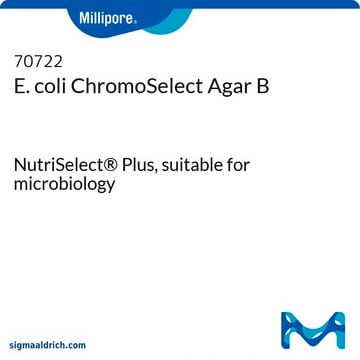CCW4721
Coliforms Chromogenic Agar Plates
Solid, selective, and differential culture medium for the detection and enumeration of total coliform and E. coli in water samples by the membrane-filtration technique acc. to ISO, suitable for microbiology
Synonym(s):
CCA
About This Item
Recommended Products
Agency
ISO 9308-1:2014
Quality Level
form
solid
shelf life
5 mo. (Expiry date on the label)
feature
ready-to-use
composition
agar, 13.00 g/L
5-bromo-4-chloro-3-indoxyl-β-D-glucuronic acid, 0.10 g/L
6-chloro-3-indoxyl-β-D-galactopyranoside, 0.10 g/L
di-sodium hydrogen phosphate, 2.70 g/L
enzymatic digest of casein, 1.00 g/L
IPTG, 0.10 g/L
sodium chloride, 5.00 g/L
Sodium dihydrogen phosphate dihydrate, 2.20 g/L
sodium pyruvate, 1.00 g/L
sorbitol, 1.00 g/L
Tergitol™ 7, 0.15 g/L
tryptophan, 1.00 g/L
yeast extract, 2.00 g/L
packaging
box of 30 plates
storage condition
(Store dry and tightly closed)
parameter
9 mL filling volume
plate diam.
55 mm
color
pale yellow
pH
6.8±0.2 (25 °C)
application(s)
food and beverages
microbiology
storage temp.
2-25°C
suitability
Escherichia coli
coliforms
General description
Application
Components
Other Notes
Legal Information
Storage Class Code
13 - Non Combustible Solids
WGK
WGK 1
Flash Point(F)
Not applicable
Flash Point(C)
Not applicable
Choose from one of the most recent versions:
Certificates of Analysis (COA)
Don't see the Right Version?
If you require a particular version, you can look up a specific certificate by the Lot or Batch number.
Already Own This Product?
Find documentation for the products that you have recently purchased in the Document Library.
Our team of scientists has experience in all areas of research including Life Science, Material Science, Chemical Synthesis, Chromatography, Analytical and many others.
Contact Technical Service







